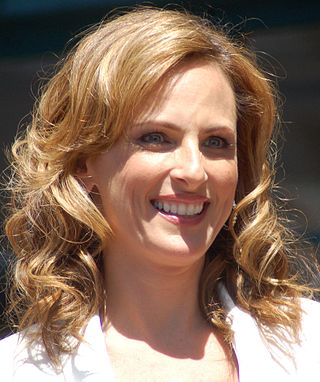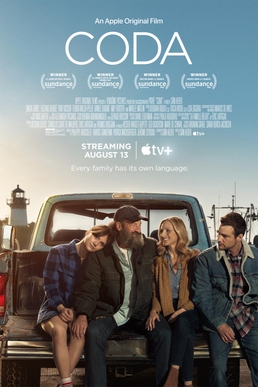Related Research Articles

American Sign Language (ASL) is a natural language that serves as the predominant sign language of Deaf communities in the United States of America and most of Anglophone Canada. ASL is a complete and organized visual language that is expressed by employing both manual and nonmanual features. Besides North America, dialects of ASL and ASL-based creoles are used in many countries around the world, including much of West Africa and parts of Southeast Asia. ASL is also widely learned as a second language, serving as a lingua franca. ASL is most closely related to French Sign Language (LSF). It has been proposed that ASL is a creole language of LSF, although ASL shows features atypical of creole languages, such as agglutinative morphology.

Marlee Beth Matlin is an American actress, author, and activist. She is the recipient of numerous accolades, including an Academy Award, a Golden Globe Award, a Screen Actors Guild Award, in addition to nominations for a BAFTA Award, and four Primetime Emmy Awards.
Signing Exact English is a system of manual communication that strives to be an exact representation of English language vocabulary and grammar. It is one of a number of such systems in use in English-speaking countries. It is related to Seeing Essential English (SEE-I), a manual sign system created in 1945, based on the morphemes of English words. SEE-II models much of its sign vocabulary from American Sign Language (ASL), but modifies the handshapes used in ASL in order to use the handshape of the first letter of the corresponding English word.
Cued speech is a visual system of communication used with and among deaf or hard-of-hearing people. It is a phonemic-based system which makes traditionally spoken languages accessible by using a small number of handshapes, known as cues, in different locations near the mouth to convey spoken language in a visual format. The National Cued Speech Association defines cued speech as "a visual mode of communication that uses hand shapes and placements in combination with the mouth movements and speech to make the phonemes of spoken language look different from each other." It adds information about the phonology of the word that is not visible on the lips. This allows people with hearing or language difficulties to visually access the fundamental properties of language. It is now used with people with a variety of language, speech, communication, and learning needs. It is not a sign language such as American Sign Language (ASL), which is a separate language from English. Cued speech is considered a communication modality but can be used as a strategy to support auditory rehabilitation, speech articulation, and literacy development.

Sue Thomas: F.B.Eye is a Canadian/American television series that premiered in 2002 on the PAX Network. The show ended in May 2005 due to PAX's decision to halt the production of original programming. It was one of the two highest rated shows on the network, along with Doc.

Signing Time! is an American television program targeted towards children aged one through eight that teaches American Sign Language. It is filmed in the United States and was created by sisters Emilie Brown and Rachel Coleman, the latter of whom hosts the series. Between the years 2002 and 2008, it was aired by American Public Television in many cities across the US. Signing Time! is produced and distributed by Two Little Hands Productions, which is located in Salt Lake City, Utah.
In the United States, deaf culture was born in Connecticut in 1817 at the American School for the Deaf, when a deaf teacher from France, Laurent Clerc, was recruited by Thomas Gallaudet to help found the new institution. Under the guidance and instruction of Clerc in language and ways of living, deaf American students began to evolve their own strategies for communication and for living, which became the kernel for the development of American Deaf culture.
Singapore Sign Language, or SgSL, is the native sign language used by the deaf and hard of hearing in Singapore, developed over six decades since the setting up of the first school for the Deaf in 1954. Since Singapore's independence in 1965, the Singapore deaf community has had to adapt to many linguistic changes. Today, the local deaf community recognises Singapore Sign Language (SgSL) as a reflection of Singapore's diverse linguistic culture. SgSL is influenced by Shanghainese Sign Language (SSL), American Sign Language (ASL), Signing Exact English (SEE-II) and locally developed signs.

Swedish Sign Language is the sign language used in Sweden. It is recognized by the Swedish government as the country's official sign language, and hearing parents of deaf individuals are entitled to access state-sponsored classes that facilitate their learning of SSL. There are fewer than 10,000 speakers, making the language officially endangered.

Universal Signs is a modern American Sign Language (ASL) film from 2008.
American Sign Language literature is one of the most important shared cultural experiences in the American deaf community. Literary genres initially developed in residential Deaf institutes, such as American School for the Deaf in Hartford, Connecticut, which is where American Sign Language developed as a language in the early 19th century. There are many genres of ASL literature, such as narratives of personal experience, poetry, cinematographic stories, folktales, translated works, original fiction and stories with handshape constraints. Authors of ASL literature use their body as the text of their work, which is visually read and comprehended by their audience viewers. In the early development of ASL literary genres, the works were generally not analyzed as written texts are, but the increased dissemination of ASL literature on video has led to greater analysis of these genres.
Ella Mae Lentz is a Deaf American author, poet, teacher, and advocate.
The sociolinguistics of sign languages is the application of sociolinguistic principles to the study of sign languages. The study of sociolinguistics in the American Deaf community did not start until the 1960s. Until recently, the study of sign language and sociolinguistics has existed in two separate domains. Nonetheless, now it is clear that many sociolinguistic aspects do not depend on modality and that the combined examination of sociolinguistics and sign language offers countless opportunities to test and understand sociolinguistic theories. The sociolinguistics of sign languages focuses on the study of the relationship between social variables and linguistic variables and their effect on sign languages. The social variables external from language include age, region, social class, ethnicity, and sex. External factors are social by nature and may correlate with the behavior of the linguistic variable. The choices made of internal linguistic variant forms are systematically constrained by a range of factors at both the linguistic and the social levels. The internal variables are linguistic in nature: a sound, a handshape, and a syntactic structure. What makes the sociolinguistics of sign language different from the sociolinguistics of spoken languages is that sign languages have several variables both internal and external to the language that are unique to the Deaf community. Such variables include the audiological status of a signer's parents, age of acquisition, and educational background. There exist perceptions of socioeconomic status and variation of "grassroots" deaf people and middle-class deaf professionals, but this has not been studied in a systematic way. "The sociolinguistic reality of these perceptions has yet to be explored". Many variations in dialects correspond or reflect the values of particular identities of a community.

Marie Jean Philip was a leader in both the American and international Deaf community. She advocated for the right to a natural sign language for Deaf people. Marie was one of the original researchers studying ASL and Deaf Culture. She was active in establishing American Sign Language (ASL) as a recognized language in the colleges of Massachusetts in the early 1980s. Later, Marie was the Bilingual-Bicultural Coordinator at The Learning Center for the Deaf in Framingham, Massachusetts.
Terrylene Sacchetti is a deaf actress from Chicago, Illinois. She graduated from the Model Secondary School for the Deaf in 1985.
Beth S. Benedict is a professor in the Department of Communication Studies at Gallaudet University, advocate for the deaf, and a mentor for families with deaf children. Her research focuses on early intervention, early language acquisition, and family involvement. Benedict is also an advocate for the use of bilingualism in education of the deaf - incorporating the value of American Sign Language in deaf children. Benedict advocates for deaf-hearing partnerships, avoiding audism, the importance of bilingual education, deaf culture and the use of sign language while also working as a family mentor for families with deaf children. Recently, she was a keynote speaker for an International Deaf Studies conference and the featured speaker for the deaf education summit. Benedict takes what she researches about deafness and education and shares it broadly by way of talks and application - for example, she has helped the Georgia School for the Deaf work on developing bilingual education in their programs. In 2015 Benedict was the featured speaker at the Deaf education summit in Louisiana - a conference that brought together practitioners, educators, and parents to discuss local issues surrounding education of deaf children.

No Ordinary Hero: The SuperDeafy Movie is a 2013 American drama film directed by Troy Kotsur and produced by Douglas Matejka and Hilari Scarl, with music score by H. Scott Salinas. The film stars John Maucere as Tony Kane/SuperDeafy and Zane Hencker as Jacob Lang. The film tells the story of a deaf actor who portrays a superhero on a children's television show and wants to help a young deaf boy who gets bullied at school. The film is open captioned in English.

CODA is a 2021 coming-of-age comedy-drama film written and directed by Sian Heder. An English-language remake of the 2014 French-Belgian film La Famille Bélier, it stars Emilia Jones as Ruby Rossi, the titular child of deaf adults (CODA) and only hearing member of her family, a teenager who attempts to help her family's struggling fishing business while pursuing her own aspirations of being a singer.

Troy Michael Kotsur is an American actor in theater, film, and television. His supporting role in the film CODA (2021) earned him a number of accolades, including an Academy Award, a British Academy Film Award, a Screen Actors Guild Award, and a Critics' Choice Movie Award. He is the first deaf actor to win the latter three awards, and first deaf man and second deaf performer overall to win the first.

Shaylee Mansfield is an American actress and former YouTuber who is deaf. Mansfield was born in Burbank, California, and first gained recognition by making viral videos in which she tells Christmas stories in American Sign Language. Mansfield appeared in an "Unforgettable Stories" video advertisement by Disney Parks, in which she met Minnie Mouse, who was learning sign language at Walt Disney World. The video quickly went viral and became one of Disney's most-watched advertisements.
References
- ↑ Bob Ayers (December 2004). Deaf Diaspora, The Third Wave of Deaf Ministry. Lincoln, NE, USA. p. 57. ISBN 0-595-33541-1.
- ↑ "Deaf actors from Oak Park star in play premiering in Hollywood". Archived from the original on July 14, 2018. Retrieved September 28, 2019.
- ↑ "A Hearing Loss Hero" (PDF). Archived (PDF) from the original on September 28, 2019. Retrieved September 28, 2019.
- ↑ "American Sign Language Honor Society". Archived from the original on September 28, 2019. Retrieved September 28, 2019.
- ↑ Your Pregnancy What to Expect. ISBN 0977097455.
- ↑ "Your Pregnancy What to Expect". Archived from the original on September 28, 2019. Retrieved September 28, 2019.
- ↑ "Seeking sign language support - Deaf actress advocates for early ASL development". 3 April 2017. Archived from the original on 6 April 2017. Retrieved September 28, 2019.